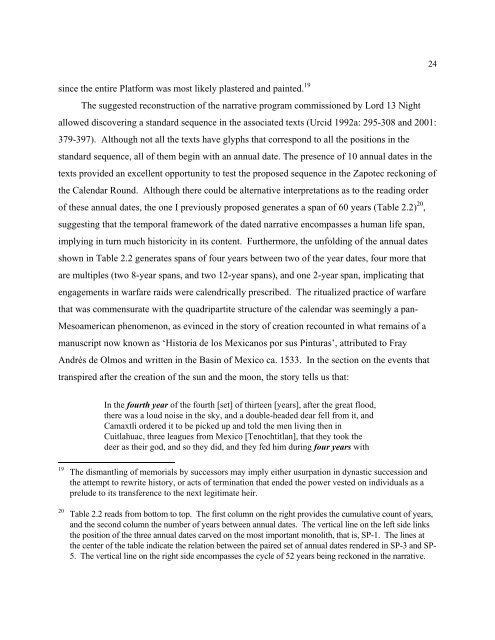Create successful ePaper yourself
Turn your PDF publications into a flip-book with our unique Google optimized e-Paper software.
since the entire Platform was most likely plastered and painted. 19<br />
The suggested reconstruction of the narrative program commissioned by Lord 13 Night<br />
allowed discovering a standard sequence in the associated texts (Urcid 1992a: 295-308 and 2001:<br />
379-397). Although not all the texts have glyphs that correspond to all the positions in the<br />
standard sequence, all of them begin with an annual date. The presence of 10 annual dates in the<br />
texts provided an excellent opportunity to test the proposed sequence in the <strong>Zapotec</strong> reckoning of<br />
the Calendar Round. Although there could be alternative interpretations as to the reading order<br />
of these annual dates, the one I previously proposed generates a span of 60 years (Table 2.2) 20 ,<br />
suggesting that the temporal framework of the dated narrative encompasses a human life span,<br />
implying in turn much historicity in its content. Furthermore, the unfolding of the annual dates<br />
shown in Table 2.2 generates spans of four years between two of the year dates, four more that<br />
are multiples (two 8-year spans, and two 12-year spans), and one 2-year span, implicating that<br />
engagements in warfare raids were calendrically prescribed. The ritualized practice of warfare<br />
that was commensurate with the quadripartite structure of the calendar was seemingly a pan-<br />
Mesoamerican phenomenon, as evinced in the story of creation recounted in what remains of a<br />
manuscript now known as ‘Historia de los Mexicanos por sus Pinturas’, attributed to Fray<br />
Andrés de Olmos and written in the Basin of Mexico ca. 1533. In the section on the events that<br />
transpired after the creation of the sun and the moon, the story tells us that:<br />
In the fourth year of the fourth [set] of thirteen [years], after the great flood,<br />
there was a loud noise in the sky, and a double-headed dear fell from it, and<br />
Camaxtli ordered it to be picked up and told the men living then in<br />
Cuitlahuac, three leagues from Mexico [Tenochtitlan], that they took the<br />
deer as their god, and so they did, and they fed him during four years with<br />
19 The dismantling of memorials by successors may imply either usurpation in dynastic succession and<br />
the attempt to rewrite history, or acts of termination that ended the power vested on individuals as a<br />
prelude to its transference to the next legitimate heir.<br />
20 Table 2.2 reads from bottom to top. The first column on the right provides the cumulative count of years,<br />
and the second column the number of years between annual dates. The vertical line on the left side links<br />
the position of the three annual dates carved on the most important monolith, that is, SP-1. The lines at<br />
the center of the table indicate the relation between the paired set of annual dates rendered in SP-3 and SP-<br />
5. The vertical line on the right side encompasses the cycle of 52 years being reckoned in the narrative.<br />
24

















